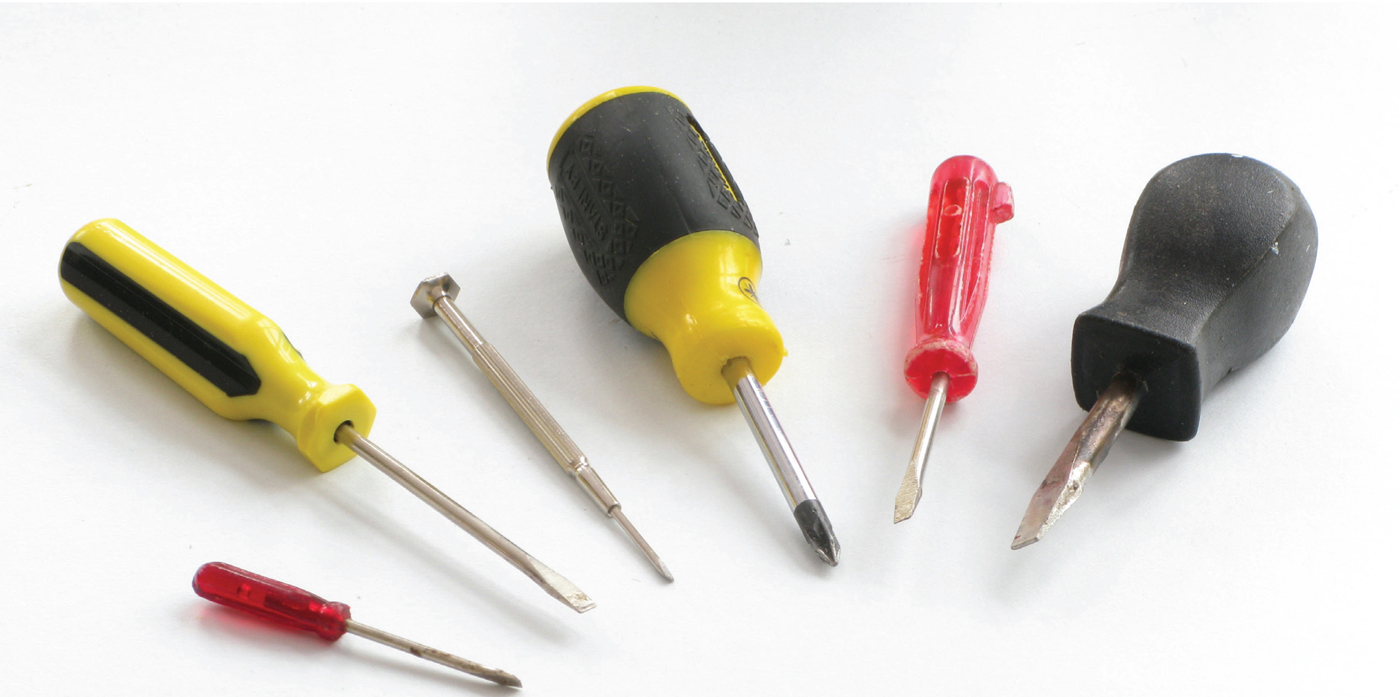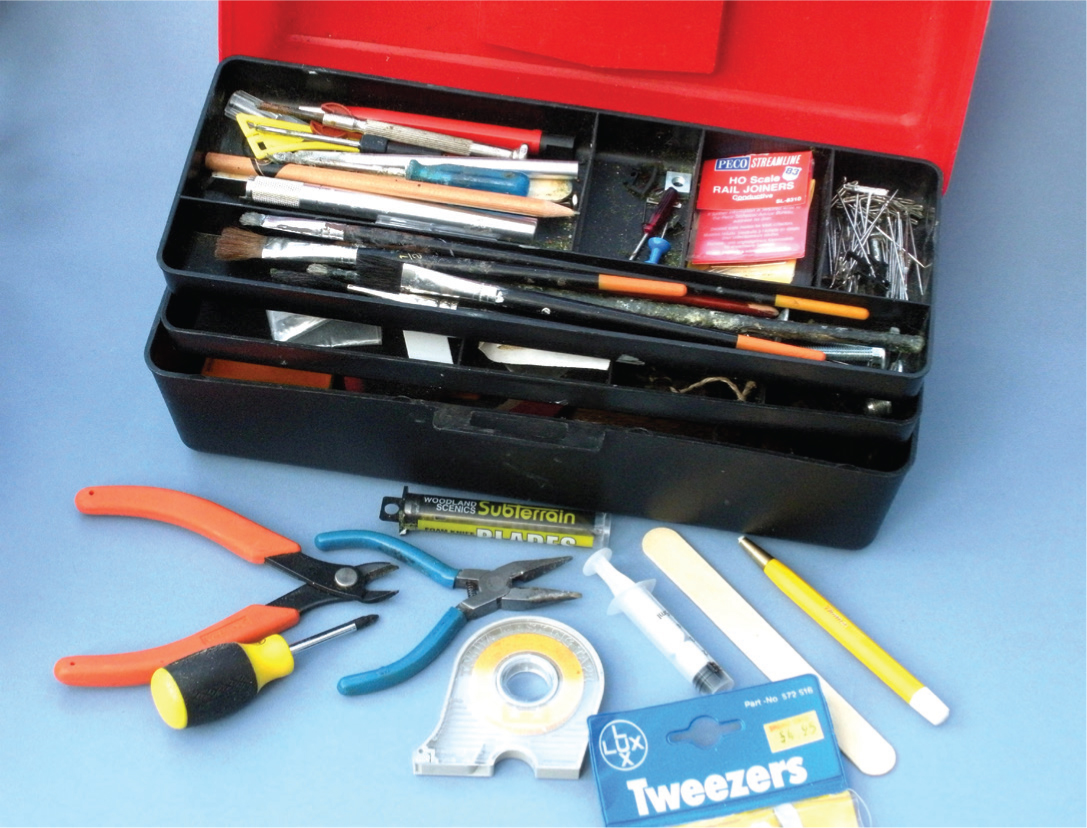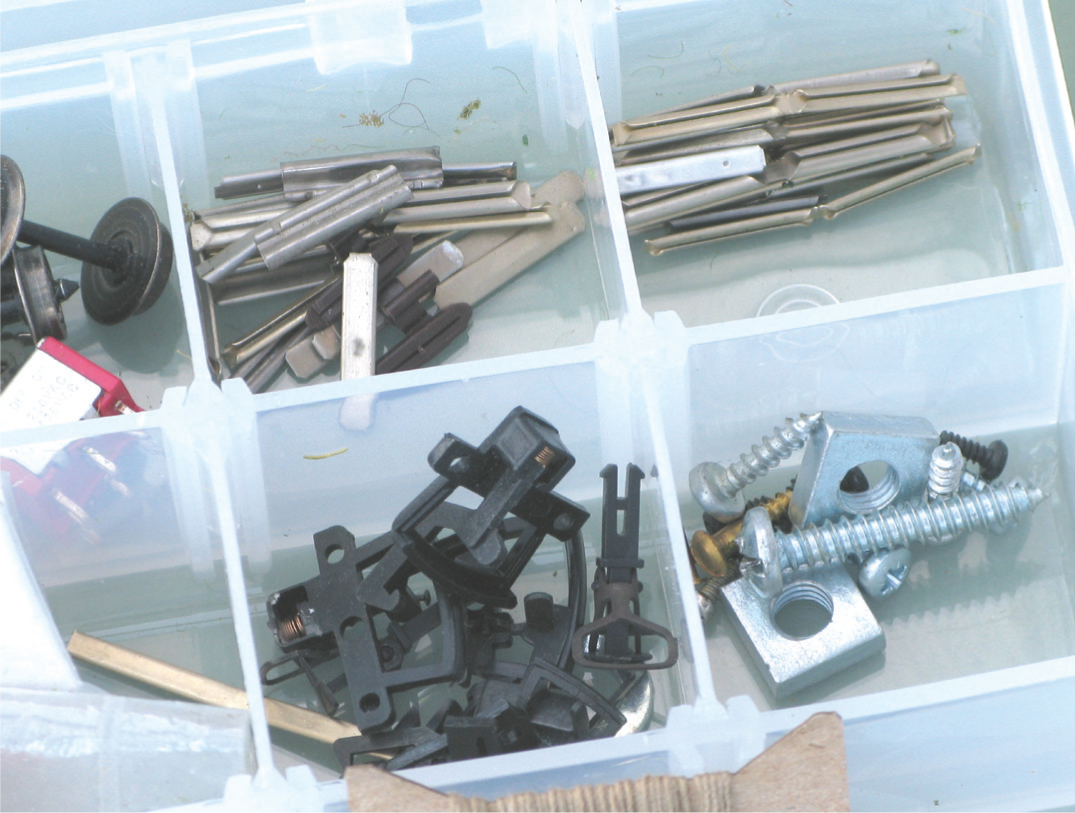
The basic tools for making baseboards include a rechargeable electric drill, set square, saw, pencil for marking out, steel ruler, paintbrush for the PVA adhesive, a surform and a screwdriver.
THE TOOLS YOU WILL NEED
Just knowing what tools are available can be a good way to improve your skills.
The basic tools that will be needed to make a layout are both readily available and inexpensive. Most of us have a large DIY store near to our home and we may well already have some of the necessary tools in our shed or garage. Some of these tools are specifically made for the modeller, whilst others have other primary uses, but can be useful for railway modellers too. Having the right tools makes modelling easier, quicker and more successful. Tools generally last a long while and we get so familiar with them that we don’t even think about them – but we would be lost without them.
Tool suppliers regularly attend the larger model railway exhibitions. Suppliers include: Squires (www.squirestools.com); Eileen’s Emporium (www.eileensemporium.com); Expo Tools (www.expotools.com) and more. Gaugemaster retails its own expanding brand of tools (www.gaugemaster.com) and Hobbycraft stores carry a good range of tools (www.hobbycraft.co.uk).
Health warning Remember that all tools can be dangerous. Store them and use them well out of reach of children and pets. Do not leave them where folks can trip over them. Wear protective eye protection and other clothing as recommended by the manufacturer. When working with adhesives or paint, keep the room well ventilated.

The basic tools for making baseboards include a rechargeable electric drill, set square, saw, pencil for marking out, steel ruler, paintbrush for the PVA adhesive, a surform and a screwdriver.

Clamps are very useful tools. Either made from plastic or metal, they perform valuable functions holding parts of kits in position while the adhesive sets, holding backscenes in position, holding the timber of a baseboard together as the adhesive dries and other tasks where an extra pair of hands is invaluable.
CLAMPS
Small plastic spring clamps are a real boon for kit building. Whilst assembling parts, they can be used to hold two or more pieces together as the glue sets. These can be bought very cheaply at model railway shows from various companies, with some of the clamps retailing at less than £1 each. Metal G clamps are also available for heavier duty tasks, such as holding together baseboard parts while the adhesive dries.
Useful for: Holding in position temporary back scenes, holding together parts of kits while the adhesive dries and holding baseboard parts together while the adhesive dries
Supplier: They can be bought at model railway shows and from specialist suppliers.
COFFEE STIRRERS OR ICED-LOLLY STICKS
Stirrers can be used to make fences for level crossings and anywhere else that real wood can be used on a layout. Some materials used scenically on a layout do not take kindly to being dragged along with a paintbrush or metal tool, such as Woodland Scenics Realistic Water. To ‘handle’ such viscous fluids it is recommended that a small wooden stick be used for this.
Useful for: Dragging resin-based water fluid to the edge of a water feature, shaping rock faces as the rock moulding plaster sets, stirring paint.
Supplier: Your favourite iced lolly! Alternatively, various scenic manufacturers supply them in their scenery kits. Of course, coffee shops usually have a jar full of them near to their checkout, so when you buy your next coffee remember to save your stirrer!
One of the staples of modelling tasks is the craft knife. These need fresh new blades for every new modelling task, because a new blade cuts cleanly and quickly and is much less frustrating than a blade that snags whilst it cuts. Poor blades increase the time taken to do anything, because it might mean that the same job has to be done twice if the first job was not good enough.
Useful for: Cutting cardboard and plastic card of all shapes and sizes. Working on locomotive detailing and modification projects, laying flexible track and much more. At least one of these is an essential item in the toolbox, plus some spare blades.
Supplier: Art shops, DIY stores, stationers, hardware stores, Hobbycraft, model shops and specialist tool suppliers and at model railway shows.

To the left is a standard craft knife with spare blades and to the right is a Woodland Scenics Foam Knife with its longer blades, which are good for cutting through hard foam. As with all craft knifes, have plenty of spare new blades in stock because blunt blades are time-consuming to work with and they will make it very difficult to achieve good results.
FILES
A set of small files is useful for a number of tasks ranging from tracklaying, remedying any small moulding faults on figures and accessories, as well as reducing the size of buffer-beam pipes so that they will fit in the small holes on the buffer beam when detailing locomotives.
Useful for: Smoothing the edges of cut rail when laying track. Removing excess burr on metal or plastic kits. Detailing locomotives.
Supplier: DIY stores, hardware stores, Hobbycraft, model shops and specialist tool suppliers at model railway shows.

Needle and small files are essential for working with flexible track – where the rail is cut the edges may be jagged, which could cause derailments and cut fingers. Small files are also useful for removing burr from kit parts and when adding detailing parts to locomotives.
To clean the top and sides of the moving rails on the points that have been weathered or to get into small spaces, there is little to touch the cleaning ability of a fibreglass brush. It works on the same principle as a propelling pencil and so enables the fibres to be pushed out as demanded. I find that these tools can be useful too for cleaning fine burr from plastic or metal parts of kits. They are also good for scratching (distressing) the sides of wagons and imitation steel girder bridges and so on to give a well-worn look.
Health warning Do not touch the ends of the fibreglass bristles because they can easily get stuck into one’s fingers, causing irritation.
Useful for: Cleaning the points after weathering. Also a good weathering tool in itself and for removing fine blemishes on kits and other models.
Supplier: Specialist tool suppliers and at model railway shows.

A fibreglass retractable brush is excellent for track cleaning (particularly on the moving parts of the points) and distressing wagons. Refills are available and the brushes are sold in various thicknesses.
HAMMER
We have generally got a hammer or two in the garage or the shed. For making baseboards, domestic hammers are useful, but for modelling tasks, such as knocking in track pins, the smaller craft hammers or even toffee hammers are useful.
Useful for: Baseboard construction and knocking in track pins
Supplier: DIY stores, hardware shops, large supermarkets and specialist tool suppliers.

The larger hammer is useful for making a baseboard, but the smaller craft hammer is best for working with track pins where the much smaller head will fit through the rails.
Sometimes even the smallest paintbrush seems too large for the finest painting job. These tiny brushes feature a bendable bristle brush. They are sold in two types – with the familiar bristle head and almost a pom-pom of tiny fibres to form a rounder head to the brush. These brushes (they are called ‘applicators’ on the packets) can easily be bent to any angle. I have tried them with paint on small areas and found them to be very useful. They will also be suitable for the placement of small controlled amounts of material, such as adhesive, lubricant and solvent when modifying locomotive detailing. They come in regular, fine and superfine sized heads.
Useful for: Ideal for all scales. A great, cheap way of applying a small amount of paint. Very versatile for locomotive detailing and fine painting.
Supplier: Available in the UK from www.modeljunction.info and other retailers.

Three micro-paintbrushes with different heads. The plastic handles of these brushes are flexible and can be bent to get into difficult corners. Such brushes are ideal for fine painting on rolling stock, figures and buildings.
MINI-DRILL
Mini-drills are made by a number of companies. Most are mains-powered, but some are rechargeable. They are useful when making a baseboard, but also when adding details to the layout and modifying rolling stock. A set of different sized drills is also needed.
Useful for: Drilling holes in the baseboard to take wires, making holes to take fence posts, telegraph posts, railway signs and so on. Drilling out small holes in locomotives to take buffer-beam details, air pipes and so on.
Supplier: Available from model shops, specialist suppliers and some hobby shops.

Electric mini-drills are important in a modeller’s toolkit for drilling holes in the baseboard to take signal posts, telegraph poles and traffic signs. They are also good for drilling small holes in locomotive buffer beams to add parts and to take wire handrails.
One can never have too many paintbrushes. Because they do wear out after a time, it is always worth having a few replacements in stock. Flat brushes are good for painting the larger areas, whilst pinpoint brushes are best for finer work. There is no need to buy expensive paintbrushes if the work is to cover large areas, such as the base colour of the scenery, or painting the grey of a road. Good-quality brushes are important for painting fine detail, such as the detail on figures.
Useful for: Applying adhesive and painting the landscape, roads, platforms and buildings. Painting loco details and figures. Can also be used in the weathering process on buildings, bridges, wagons and rolling stock.
Supplier: Art shops, some supermarkets and specialist tool suppliers at model railway shows.

A selection of paintbrushes, Woodland Scenics T-Pins plus a wooden stick similar to a coffee stirrer or iced-lolly stick that are useful for a multitude of small jobs, such as working with water fluids and sculpting rock faces.
PICK AND PLACE TOOL
This is a tool like a pen with a small sticky tip on the end that is useful for picking up and placing small parts such as locomotive details. To regain the sticky tension on the point, just roll the tip on adhesive tape.
Useful for: Picking up detail parts when they are fiddly, such as locomotive details.
Supplier: Available from Gaugemaster and others.
PLASTIC SYRINGE
A plastic syringe is very handy for dispensing a controlled amount of liquid. When the fluid is diluted (for example, PVA glue), this assists the smooth flow of the fluid from the tool. Deluxe Materials retail a Pin Point Syringe Kit that includes two syringes and three sizes of stainless-steel tips. Wash the tip of the bottle or pipette after each use to ensure that the tool stays free of hardened glue.
Useful for: Applying PVA (diluted) on to ballast or scenic areas. Applying water materials (such as Woodland Scenics Realistic Water or Deluxe Materials Scenic Water) in confined areas such as streams or small puddles.
Supplier: Deluxe Materials, Hobbycraft and specialist tool suppliers at model railway shows.

A plastic syringe can be very useful for dispensing diluted PVA for ballasting and scenic work. It is useful also for carefully pouring water fluids, such as resin-based liquids. Practise pushing the plunger slowly and steadily until you feel confident working with it.
PUFFER
Using a puffer is a great way to rid the layout, a building or an item of rolling stock of stray scenic material, dust or static grass fibres. It is also very useful when you are taking photographs of a layout and rolling stock.
Useful for: Blowing away dust and excess scenery materials. Preparing the layout and rolling stock for a photographic shoot.
Supplier: Specialist tool suppliers at model railway shows and photographic shops.

To the left is a photographic puffer bottle for removing dust from a camera lens and to the right is a larger rubber-based puffer bottle that works very well blowing away dust and excess scenic materials. Both are good when cleaning debris from a layout and especially when taking photographs of your layout and rolling stock.
SCREWDRIVERS
We all have a number of screwdrivers at home. Some have flat blades, some are of the Phillips cross-head type. Some are small; others are large. For making baseboards, the domestic sized screwdrivers are useful. For modelling tasks, smaller screwdrivers are preferable, for example when dismantling items of rolling stock.
Useful for: Baseboard construction, disassembling and reassembling locomotives and road vehicles.
Supplier: DIY stores, hardware shops, large supermarkets and specialist tool suppliers.

A selection of screwdrivers for an enormous number of tasks, from building the baseboard to reassembling a locomotive. Should its blades become damaged, it is best to dispose of the screwdriver because it will never work well again.
SELF-SEALING CUTTING BOARD
Get the largest cutting board that you can accommodate on your workbench so that you may be able to cut cardboard or plastic card in one cut rather than two sweeps of the blade. These are one of the workbench essentials for scratch-building platforms and buildings, when making kits and generally as protection for the desk or table.
Useful for: Cutting cardboard, wood and plastic. Also useful when cutting the parts from sprues of kits of all types of material.
Supplier: Art shops, hardware shops and specialist tool suppliers at model railway shows.

A self-sealing cutting board is essential for any form of kit making because it protects the desk or workbench. Steel rulers are necessary when cutting most materials and a small pair of cheap scissors is suitable for cutting stray pieces of scenery fibres and foliage.
A steel ruler is recommended rather than one made from plastic or wood, because the blade of a sharp craft knife will not cut into a steel ruler. It is essential when cutting cardboard, plastic or wood. Go for a 30cm (12in) ruler rather than a 15cm (6in) one when needing to cut larger pieces.
Useful for: When cutting cardboard, laser-cut kits and plastic of all shapes and sizes.
Supplier: Art shops, hardware shops, DIY stores and specialist tool suppliers at model railway shows.
T-PINS
These packs of Woodland Scenics T-shaped metal pins are around 5cm (2in) long. They are really useful for holding together scenery as the adhesive sets and for supporting trees and other accessories as they are being fixed into the landscape.
Useful for: Supporting trees, fence posts and other items whilst the adhesive holding them is drying and for holding hard foam scenery in place whilst the glue dries.
Supplier: Woodland Scenics; for dealers, see www.bachmann.co.uk.
TWEEZERS
What would we do without tweezers? They are good for holding figures and accessories as we add details to our layouts. They are useful for pushing signs into place on buildings, placing fence posts in drilled holes in the baseboard and picking up and sliding locomotive numbers into place. They can be bought singly, or in packs with a variety of types of tweezers.
Useful for: Holding fine accessories whilst positioning them. Handling figures, signs, detailing parts, fence posts and much more.
Supplier: Some hardware stores or specialist tool suppliers at model railway shows.

This set of tweezers cost less than £3 from a model railway show, but has served me well on numerous tasks over a decade or more. If you get dried glue on the tweezers, pour on boiling hot water to remove it.

It is worth buying a plastic toolbox in which to store all your tools. There is nothing more frustrating than having to search for tools and by the time you have found the required tools for a task your enthusiasm for the modelling may well have disappeared.

There are many plastic storage boxes available for storing scenic materials such as static grass fibres. This storage box has nine large trays, plus there are additional smaller storage compartments in the lid. Because these are made from plastic they are easy to move around the house or garage, or take to model railway shows.

A small plastic box with a lid is a good way to store track bits and pieces such as track pins, fishplates, spare wheels and couplings. These boxes can be stacked on top of one another and are also suitable for storing road vehicles, figures and detailing accessories.

A close-up of a plastic box with track bits. These plastic boxes are light in weight and are available from hobby stores, DIY stores and discount shops.